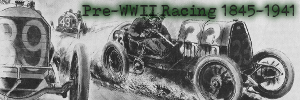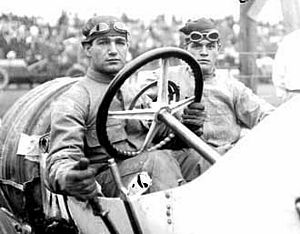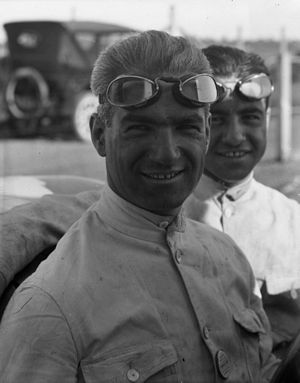















Ralph DePalma |
|---|

|
| Topic Navigation |
|---|
|
Wikipedia: Ralph DePalma
Page Sections Biography Photographs Article Index |
Biography
The following section is an excerpt from Wikipedia's Ralph DePalma page on 10 May 2020, text available via the Creative Commons Attribution-ShareAlike 3.0 Unported License.
Raffaele "Ralph" De Palma was an Italian-American racecar driving champion who won the 1915 Indianapolis 500. His entry at the International Motorsports Hall of Fame estimates that he won about 2,000 races. DePalma won the 1908, 1909, 1910, and 1911 American AAA national dirt track championships and is credited with winning 24 American Champ car races. He won the Canadian national championship in 1929. DePalma estimated that he had earned $1.5 million by 1934 after racing for 27 years. He is inducted in numerous halls of fame. He competed on boards and dirt road courses and ovals.
Born in Biccari, Apulia, Italy, DePalma's family emigrated to the United States in 1893. As a young man he tried bicycle racing with mixed success, but at the age of twenty-two he began racing motorcycles before switching to the automobile dirt track racing circuit in 1909, the year that the American Automobile Association established the national driving championship.
DePalma was immediately successful in car racing. In 1911, DePalma won the first Milwaukee Mile Championship Car race. However, he is still remembered for the dramatic manner in which he lost the 1912 Indianapolis 500. After leading the race for 196 of the 200 laps, his Mercedes cracked a piston and with only 2 laps remaining; he and his mechanic had to push the car across the finish line to take eleventh place. At that time, only cars completing the full 200 laps received any prize money. This Mercedes remains on display at the Indianapolis Motor Speedway Hall of Fame Museum.
He went on to earn the U.S. national driving championship that year, but was almost killed in an accident on October 5 at the Grand Prize held in a road course in Milwaukee. After being impaled by a corn stalk, he was hospitalized for 11 weeks; he recovered and was back to racing the following spring.
In 1912 and again in 1914, DePalma won the Elgin Trophy at Elgin, Illinois and in 1914 he scored what he called his greatest victory when he beat Barney Oldfield to capture the Vanderbilt Cup on the roads of Santa Monica, California. He entered the 1914 Indianapolis 500 and qualified, but withdrew before the race claiming he felt his engine could not survive the race. DePalma had been let go by the Mercer Automobile Co. racing team in favor of Barney Oldfield. In a Mercedes "Gray Ghost," he showed he was a master tactician in beating Oldfield's much faster car. He ended 1914 by winning his second U.S. national driving championship. The following year, 1915, he drove to victory at 1915 Indianapolis 500 with a Mercedes 4.5 liter GP car.
DePalma was an intense competitor but one of the most popular racers with his fellow drivers and the fans because of his good sportsmanship, a quality he displayed on and off the track. In June 1917 he lost to Barney Oldfield in a series of 10 to 25 mile match races at the Milwaukee Mile. On February 12, 1919 at Daytona Beach, Florida, he drove a Packard to a world speed record of 149.875 mph (241.200 km/h) over a measured mile (1.6 km). International competition began following the adoption of the three liter engine limit in the U.S. and Europe in 1920. DePalma began the year driving for the French manufacturer, Ballot. His Ballot vehicle won the pole position for the 1920 Indy race and he led for many laps but bad luck dogged him in the race (faulty bearings on the Ballot) and he did not finish. However, DePalma did race his Ballot vehicle in the Elgin Road Race and won his third Elgin trophy in 1920. Then in 1921 DePalma traveled with other Americans to Le Mans to compete in the French Grand Prix. There, he finished second to the Duesenberg driven by fellow American, Jimmy Murphy. DePalma won the Canadian national championship in 1929.
DePalma later competed in stock cars until he retired from racing in 1936. In his career, he competed in 2,889 races in America and Europe and won 2,557, according to his Associated Press obituary that appeared in the Detroit Free Press on April 1, 1956. He was an honorary referee for the Indianapolis 500, the last time in 1954.
He died at his home in South Pasadena, California, from cancer on March 31, 1956 at age 73. He was interred in the Holy Cross Cemetery in Culver City, California.
 |
Subject: Ralph DePalma (left) & Tom Alley (right)
Source: United States Library of Congress Event: Elgin Road Races, August 1912 View photo of Ralph DePalma and Tom Alley in Elgin Illinois - 42KB |
 |
Subject: Ralph DePalma (left) & Pete DePaolo (right)
Source: Marvin D. Boland Collection Event: Tacoma Speedway, 1920 Caption: Ralph DePalma (front) squinted as he smiled into the camera, his goggles pushed up on his forehead, in July of 1920. Behind him is his nephew, Peter DePaolo, future winner of 1925 Indianapolis 500. Ralph DePalma was one of the crowds' favorites entered in the July 5th, 1920 Tacoma Classic auto race at the Tacoma Speedway. He was also one of the favorites of the other drivers due to his unerring good sportsmanship both on and off the track. In his career, which spanned over 25 years beginning early in the century, DePalma won over 2000 races on every surface imaginable. He took every major prize including the Vanderbilt Cup, Savannah Grand Prize, Elgin National Trophy and the Indianapolis 500. He is probably best remembered, however, for a race he lost. In the 1912 Indy 500, after leading for 196 of 200 laps, DePalma's Mercedes cracked a piston, putting him out of the race. He and his mechanic proceeded to push the car the remaining mile and over the finish line, an image that came to represent the race, and overshadowed the winner that year. (TDL 7/5/1920, pg. 3; www.motorsportshalloffame; hickoksports.com; wikipedia) Speedway 116 View photo of Ralph DePalma and Pete DePaolo at Tacoma Speedway, 1920 - 287KB |
